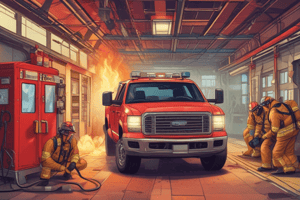Podcast
Questions and Answers
What is the initial action to take when dispatched to a report of an odor in a neighborhood or at a particular address?
What is the initial action to take when dispatched to a report of an odor in a neighborhood or at a particular address?
In a situation involving an active drug laboratory, what should be done with materials found on site?
In a situation involving an active drug laboratory, what should be done with materials found on site?
If a fire situation is discovered at a location that also has a drug lab, what is the recommended response?
If a fire situation is discovered at a location that also has a drug lab, what is the recommended response?
Which of the following should NOT be done when arriving at a suspected drug lab site?
Which of the following should NOT be done when arriving at a suspected drug lab site?
Signup and view all the answers
What is the primary concern when responding to a reported drug lab with flammable odors?
What is the primary concern when responding to a reported drug lab with flammable odors?
Signup and view all the answers
What is the primary purpose of conducting a bump test during the apparatus inspection?
What is the primary purpose of conducting a bump test during the apparatus inspection?
Signup and view all the answers
How many Mini−CO diffusion tubes should each company ideally maintain?
How many Mini−CO diffusion tubes should each company ideally maintain?
Signup and view all the answers
Where should air sampling monitors and tubes be stored?
Where should air sampling monitors and tubes be stored?
Signup and view all the answers
What is included in the weekly apparatus inspection?
What is included in the weekly apparatus inspection?
Signup and view all the answers
Where can additional Mini−CO tubes be obtained if needed?
Where can additional Mini−CO tubes be obtained if needed?
Signup and view all the answers
What action should be taken if carbon monoxide (CO) readings are between 10 ppm and 35 ppm?
What action should be taken if carbon monoxide (CO) readings are between 10 ppm and 35 ppm?
Signup and view all the answers
What is the maximum CO level that allows firefighters to enter without SCBA?
What is the maximum CO level that allows firefighters to enter without SCBA?
Signup and view all the answers
What must TFD personnel wear during a rescue operation in a contaminated environment?
What must TFD personnel wear during a rescue operation in a contaminated environment?
Signup and view all the answers
What should be done with the CO detector before entering a potentially contaminated area?
What should be done with the CO detector before entering a potentially contaminated area?
Signup and view all the answers
What is the procedure if CO levels are recorded at 9 ppm or less?
What is the procedure if CO levels are recorded at 9 ppm or less?
Signup and view all the answers
After the best entry point is identified what should be done?
After the best entry point is identified what should be done?
Signup and view all the answers
If a rescue operation occurs during a CO incident, what is the primary concern for TFD personnel?
If a rescue operation occurs during a CO incident, what is the primary concern for TFD personnel?
Signup and view all the answers
What is the flammable range of carbon monoxide?
What is the flammable range of carbon monoxide?
Signup and view all the answers
What is the significance of monitoring the door opening during entry?
What is the significance of monitoring the door opening during entry?
Signup and view all the answers
What does the acronym IDLH stand for in relation to carbon monoxide exposure?
What does the acronym IDLH stand for in relation to carbon monoxide exposure?
Signup and view all the answers
Which response should be initiated if a caller reports symptoms of medical signs or symptoms from carbon monoxide poisoning?
Which response should be initiated if a caller reports symptoms of medical signs or symptoms from carbon monoxide poisoning?
Signup and view all the answers
What is the Time Weighted Average (TWA) for carbon monoxide exposure?
What is the Time Weighted Average (TWA) for carbon monoxide exposure?
Signup and view all the answers
What action should be taken if there are no reported medical signs or symptoms after a CO detector alarm?
What action should be taken if there are no reported medical signs or symptoms after a CO detector alarm?
Signup and view all the answers
What is the immediate hazard caused by carbon monoxide in the bloodstream?
What is the immediate hazard caused by carbon monoxide in the bloodstream?
Signup and view all the answers
What sources can produce carbon monoxide?
What sources can produce carbon monoxide?
Signup and view all the answers
What should responders prioritize when handling a carbon monoxide alarm with reported symptoms?
What should responders prioritize when handling a carbon monoxide alarm with reported symptoms?
Signup and view all the answers
What should be done if the carbon monoxide (CO) source cannot be identified in a timely manner?
What should be done if the carbon monoxide (CO) source cannot be identified in a timely manner?
Signup and view all the answers
Which action must be taken if a natural gas appliance is identified as the source of CO?
Which action must be taken if a natural gas appliance is identified as the source of CO?
Signup and view all the answers
What is the acceptable level of CO that allows for reoccupation of the area after ventilation?
What is the acceptable level of CO that allows for reoccupation of the area after ventilation?
Signup and view all the answers
What should be done if CO readings exceed 35ppm?
What should be done if CO readings exceed 35ppm?
Signup and view all the answers
Which of the following actions must be documented in the logbook by company officers?
Which of the following actions must be documented in the logbook by company officers?
Signup and view all the answers
What should occupants do if the stain in the Mini-CO tube exceeds the preset points?
What should occupants do if the stain in the Mini-CO tube exceeds the preset points?
Signup and view all the answers
If CO levels are measured between 10ppm and 35ppm, what is the recommended action?
If CO levels are measured between 10ppm and 35ppm, what is the recommended action?
Signup and view all the answers
Which specialized team should be requested for assistance in locating the CO source?
Which specialized team should be requested for assistance in locating the CO source?
Signup and view all the answers
For clandestine drug labs you should notify district chief, hazmat, hazmat coordinator and the ____
For clandestine drug labs you should notify district chief, hazmat, hazmat coordinator and the ____
Signup and view all the answers
Carbon monoxide may also be known as carbon oxide, ____ gas, or monoxide
Carbon monoxide may also be known as carbon oxide, ____ gas, or monoxide
Signup and view all the answers
The flammable range of CO is 12.5 to __ %
The flammable range of CO is 12.5 to __ %
Signup and view all the answers
Study Notes
Clandestine Drug Labs
- When dispatched to reports of neighborhood odors, maintain minimum exposure; clear personnel from the area.
- Notify district chief, Hazmat, Hazmat coordinator, and TPD Special Investigations Division (SID) upon encountering flammable or irritating substances.
- In cases of discovering an active drug lab or significant chemicals, avoid altering or moving items; remove non-emergency personnel and notify relevant authorities.
- If a fire reveals a drug lab, notify all necessary departments and consider a defensive operation; halt overhaul until Hazmat assesses the situation.
Carbon Monoxide (CO) Detector Response
- CO is a colorless, odorless gas from carbon-based fuel combustion, including automobiles and gas appliances.
- It has a flammable range of 12.5% to 74%, with a Time Weighted Average (TWA) of 35ppm and an Immediately Dangerous to Life or Health (IDLH) level of 1200ppm.
- CO binds more readily to hemoglobin than oxygen, posing a significant risk of poisoning from prolonged exposure.
Procedures for CO Detector Responses
- If no medical symptoms are reported: Assign Hazmat or ladder company to non-emergency response; occupants should evacuate if possible.
- If symptoms of CO poisoning are reported: Dispatch engine, ladder, Hazmat, and EMSA for an emergency response.
- For rescues, TFD personnel must wear appropriate protective gear, including SCBA, during the entry into contaminated environments.
CO Detection Actions
- 0-9 ppm: Occupants may remain inside; provide information about CO.
- 10-35 ppm: Evacuate the structure until the CO source is managed.
- If the CO source is unknown, wait for Hazmat to investigate with specialized equipment.
Management of CO Sources
- Maintain operational fuel-burning appliances until inspected; tag any relevant controls.
- After identifying and eliminating the source, inform occupants of actions taken.
- If levels exceed 35ppm, evacuate and request Hazmat assistance, managing the incident like a 10-35ppm reading situation.
Maintenance and Monitoring
- Air sampling monitors and diffusion tubes must be stored safely, inspected weekly for functionality.
- Conduct a bump test during inspections, ensuring 5 to 10 Mini-CO diffusion tubes are available per company, with provisions for additional tubes.
Studying That Suits You
Use AI to generate personalized quizzes and flashcards to suit your learning preferences.
Description
This quiz focuses on the strategic and tactical considerations outlined in the Tulsa Fire Department's Emergency Operating Guidelines, specifically Section 300 regarding clandestine drug labs. It covers procedures for responding to hazardous odor reports and ensuring personnel safety. Test your knowledge of best practices in emergency response.





